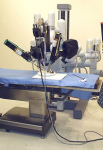 The da Vinci Surgical System was approved by the U.S. FDA in 2000 and was the product of development and research in the late 1980s by SRI International. In 1991 the National Institutes of Health provided funding and a prototype robotic surgical system was created. This caught the attention of DARPA, the agency once known as ARPA. In 1995, a group of doctors and investors optioned SRI’s intellectual property and formed Intuitive Surgical Devices, Inc. They took the SRI System as it was then known and refined it into a testing prototype in 1997. The prototypes were named after da Vinci themes, and the final version became known as the da Vinci Surgical System. The name was retained after it was commercialized.
The da Vinci Surgical System was approved by the U.S. FDA in 2000 and was the product of development and research in the late 1980s by SRI International. In 1991 the National Institutes of Health provided funding and a prototype robotic surgical system was created. This caught the attention of DARPA, the agency once known as ARPA. In 1995, a group of doctors and investors optioned SRI’s intellectual property and formed Intuitive Surgical Devices, Inc. They took the SRI System as it was then known and refined it into a testing prototype in 1997. The prototypes were named after da Vinci themes, and the final version became known as the da Vinci Surgical System. The name was retained after it was commercialized.
The current da Vinci SI system released in April of 2009 costs 1.75 million including maintenance contracts and instruments expenses. It is currently cleared for urology, gynecology, cardiac, and general surgery and is one of the foremost modern surgical robots in existence.


